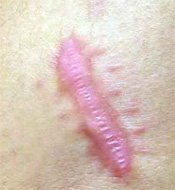
Keloids are scar tissues which grow beyond the boundaries of normal skin. In a majority of cases, keloids are large, irregular skin folds which continue enlarging with time. Once you get keloids, they rarely disappear on their own. Most surgical attempts for the treatment of keloids actually make their appearance worsened, and they may even promote further growth. Click Here to discover a research based, original guide to get rid of Keloids naturally.
What Causes Keloids?
Most of the times, keloids are seen after a surgery or trauma. Skin that grows back is irregular, raised, thick and visually very unattractive. Keloids may also develop after burns, body piercing, minor skin abrasions or tattoos. Actual causes of keloids are not yet fully understood, but studies have shown that it is more common in blacks, Asians and individuals with dark skin color. People of both genders and of all age groups can have keloids. There are even instances when keloids are seen to run within families. However, this does not mean that all members of a family will have keloids, and it is also impossible to say who will have keloids in the family and who won’t.
No part of body is immune to keloids, but most of the times, they occur on pierced ears, surgery incision sites, chest, back and shoulders. Keloids rarely develop on a patient’s face, but it may happen after an injury or incision in the area. If you have developed a keloid once for any reason, you must keep in mind that your body is prone to develop more keloids. So, you should avoid going through any unnecessary procedures which may trigger development of a keloid, such as tattooing or body piercing. Click Here to discover an unusual tip on how to get rid of Keloids.
Types of Keloids
Keloids may take a variety of forms and shapes, and may appear in any part of your body. Let us have a look at different types of keloids that a patient may develop:
Earlobe keloids: These appear as balls of tissue growing on both or one side of your earlobe.
Facial keloids: These keloids appear as nodules or flat lines on the facial region. Most of the times, these occur due to in-grown hair or acne on the face. As compared to people with other types of skin, facial keloids are more commonly seen in African Americans.
Nodular keloids: These keloids are also commonly seen in people with African American type of skin. The tissue forms the shape of a ball, and the nodule remains round in shape with glossy surface. It maintains its round shape for a long time, unless it becomes a massive keloid and loses its shape.
Flat keloids: Growth and spread of these keloids take place on the skin’s surface only, and they hardly take the form of a nodule. They are known to spread on the skin, and are more commonly found in light colored individuals and Caucasians.
Bulky keloids: These may grow on any body part, including the face. These are either caused due to over-growth of a single nodular keloid which continues to grow in size, or as a conglomerate of many nodules merging with each other. Bulky keloids are known to interfere with the patient’s daily life, as they may be noticed from under a thin clothing too, and can be pulled or irritated during sleep when the patient tosses or turns in bed. The patient may wake up with pain due to pulling.
Massive keloids: These keloids grow in large regions of body, such as neck area, shoulder or back. Such keloids have no boundaries and can spread in all directions. These may interfere with the patient’s range of motion too, in the organ which is involved. For example, if a person has massive keloids on the neck, he may lose his ability to turn the neck.
Intentional keloids: In the pre-Columbian times, people of Olmec civilization in Mexico used keloid scarification for decorating their bodies. In modern era too, Egyptian women intentionally get keloid scars on their face as a means for decoration. People of Nuer and Nuba tribes use lip plugs, use keloid tattoos along their forehead, along the chin, above lip and on cornrows. People of Papua New Guinea groups follow a ritual, in which they cut a part of their skin, and insert ash or clay into it in order to develop a permanent bump. This is a painful ritual which is used to honor members of the tribe who are enduring and courageous.
Is it Possible to Remove Keloid Scars?
Absolutely! And the good news is, you don’t have to spend your hard earned money on expensive anti-scar creams. Click Here to discover a drug-free, 100% natural way to remove Keloid Scars at home.
Leave A Comment